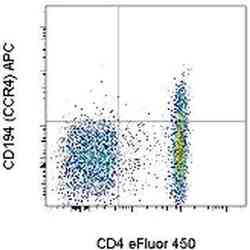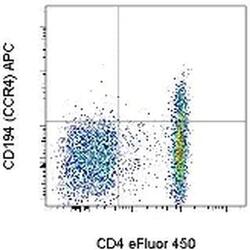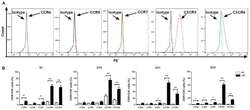17-1949-42
antibody from Invitrogen Antibodies
Targeting: CCR4
CC-CKR-4, CD194, ChemR13, CKR4, CMKBR4, k5-5
Antibody data
- Antibody Data
- Antigen structure
- References [8]
- Comments [0]
- Validations
- Flow cytometry [2]
- Other assay [1]
Submit
Validation data
Reference
Comment
Report error
- Product number
- 17-1949-42 - Provider product page

- Provider
- Invitrogen Antibodies
- Product name
- CD194 (CCR4) Monoclonal Antibody (D8SEE), APC, eBioscience™
- Antibody type
- Monoclonal
- Antigen
- Other
- Description
- Description: This D8SEE monoclonal antibody reacts with human CD194 (CCR4). CD194, also known as C-C Chemokine Receptor 4 (CCR4) is a member of the G protein-coupled receptor family, a large family characterized by seven transmembrane alpha helical domains. The ligands for CCR4 are CCL17 (TARC) and CCL22 (MDC), which direct the migration of target cells. CCR4 and its ligands, along with the other receptors CCR10 and CLA, are particularly important for the recruitment of T cells into the skin, where they may also play a role in adhesion and extravasation. Although CCR4 expression was originally believed to be restricted to Th2 cells, it has since been observed in some subsets of Th17, Treg, and Th1 cells. It is not expressed by naive T cells, indicating a role in memory or effector function. Other cells that express CCR4 are activated NK cells, platelets, monocytes, and basophils. Applications Reported: This D8SEE antibody has been reported for use in flow cytometric analysis. Applications Tested: This D8SEE antibody has been pre-titrated and tested by flow cytometric analysis of normal human peripheral blood cells. This can be used at 5 µL (0.125 µg) per test. A test is defined as the amount (µg) of antibody that will stain a cell sample in a final volume of 100 µL. Cell number should be determined empirically but can range from 10^5 to 10^8 cells/test. Excitation: 633-647 nm; Emission: 660 nm; Laser: Red Laser. Filtration: 0.2 µm post-manufacturing filtered.
- Reactivity
- Human
- Host
- Mouse
- Isotype
- IgG
- Antibody clone number
- D8SEE
- Vial size
- 100 Tests
- Concentration
- 5 μL/Test
- Storage
- 4°C, store in dark, DO NOT FREEZE!
Submitted references Application of the chemokine-chemokine receptor axis increases the tumor-targeted migration ability of cytokine-induced killer cells in patients with colorectal cancer.
Global survey of the immunomodulatory potential of common drugs.
Chloroquine inhibits human CD4(+) T-cell activation by AP-1 signaling modulation.
Regulation of inflammatory chemokine receptors on blood T cells associated to the circulating versus liver chemokines in dengue fever.
CC chemokine receptor 4 contributes to innate NK and chronic stage T helper cell recall responses during Mycobacterium bovis infection.
Paradoxical increase in skin inflammation in the absence of CCR4.
Unraveling the structure and function of G protein-coupled receptors through NMR spectroscopy.
C-C chemokine receptor 4 expression defines a major subset of circulating nonintestinal memory T cells of both Th1 and Th2 potential.
Zou Y, Liang J, Li D, Fang J, Wang L, Wang J, Zhang J, Guo Q, Yan X, Tang H
Oncology letters 2020 Jul;20(1):123-134
Oncology letters 2020 Jul;20(1):123-134
Global survey of the immunomodulatory potential of common drugs.
Vladimer GI, Snijder B, Krall N, Bigenzahn JW, Huber KVM, Lardeau CH, Sanjiv K, Ringler A, Berglund UW, Sabler M, de la Fuente OL, Knöbl P, Kubicek S, Helleday T, Jäger U, Superti-Furga G
Nature chemical biology 2017 Jun;13(6):681-690
Nature chemical biology 2017 Jun;13(6):681-690
Chloroquine inhibits human CD4(+) T-cell activation by AP-1 signaling modulation.
Schmidt RL, Jutz S, Goldhahn K, Witzeneder N, Gerner MC, Trapin D, Greiner G, Hoermann G, Steiner G, Pickl WF, Burgmann H, Steinberger P, Ratzinger F, Schmetterer KG
Scientific reports 2017 Feb 7;7:42191
Scientific reports 2017 Feb 7;7:42191
Regulation of inflammatory chemokine receptors on blood T cells associated to the circulating versus liver chemokines in dengue fever.
de-Oliveira-Pinto LM, Marinho CF, Povoa TF, de Azeredo EL, de Souza LA, Barbosa LD, Motta-Castro AR, Alves AM, Ávila CA, de Souza LJ, da Cunha RV, Damasco PV, Paes MV, Kubelka CF
PloS one 2012;7(7):e38527
PloS one 2012;7(7):e38527
CC chemokine receptor 4 contributes to innate NK and chronic stage T helper cell recall responses during Mycobacterium bovis infection.
Stolberg VR, Chiu BC, Schmidt BM, Kunkel SL, Sandor M, Chensue SW
The American journal of pathology 2011 Jan;178(1):233-44
The American journal of pathology 2011 Jan;178(1):233-44
Paradoxical increase in skin inflammation in the absence of CCR4.
Sells RE, Hwang ST
The Journal of investigative dermatology 2010 Dec;130(12):2697-9
The Journal of investigative dermatology 2010 Dec;130(12):2697-9
Unraveling the structure and function of G protein-coupled receptors through NMR spectroscopy.
Tikhonova IG, Costanzi S
Current pharmaceutical design 2009;15(35):4003-16
Current pharmaceutical design 2009;15(35):4003-16
C-C chemokine receptor 4 expression defines a major subset of circulating nonintestinal memory T cells of both Th1 and Th2 potential.
Andrew DP, Ruffing N, Kim CH, Miao W, Heath H, Li Y, Murphy K, Campbell JJ, Butcher EC, Wu L
Journal of immunology (Baltimore, Md. : 1950) 2001 Jan 1;166(1):103-11
Journal of immunology (Baltimore, Md. : 1950) 2001 Jan 1;166(1):103-11
No comments: Submit comment
Supportive validation
- Submitted by
- Invitrogen Antibodies (provider)
- Main image

- Experimental details
- Staining of normal human peripheral blood cells with Anti-Human CD4 eFluor® 450 (Product # 48-0048-42) and Anti-Human CD194 (CCR4) APC. Cells in the lymphocyte gate were used for analysis.
- Submitted by
- Invitrogen Antibodies (provider)
- Main image

- Experimental details
- Staining of normal human peripheral blood cells with Anti-Human CD4 eFluor® 450 (Product # 48-0048-42) and Anti-Human CD194 (CCR4) APC. Cells in the lymphocyte gate were used for analysis.
Supportive validation
- Submitted by
- Invitrogen Antibodies (provider)
- Main image

- Experimental details
- Figure 3. Expression levels of chemokine receptors on CIK cells generated from patients with CRC and healthy donors. (A) Analysis of the expression levels of CCR4, CCR5, CCR7, CXCR3 and CXCR4 on CIK cells via flow cytometry revealed that CXCR3 and CXCR4 had higher expression levels on CIK cells compared with isotype, expression profiles of CCR4, CCR5 and CCR7 did not show significant changes compared with isotype. (B) Dynamic changes of chemokine receptors CCR4, CCR5, CCR7, CXCR3 and CXCR4 of CIK cells on D7, 14, 21 and 28 were detected in patients with CRC and HD CIK cells via flow cytometry. The result revealed that expression levels of CXCR3 and CXCR4 were significantly higher on CIK cells cultured from CRC compared with HD at all the time points analyzed, while the expression levels of CCR4, CCR5 and CCR7 were significantly higher on CIK cells cultured from CRC compared with HD at different time points analyzed (CCR4 on D7 and D28; CCR5 on D28; CCR7 on D7, D21 and D28). All comparisons were performed using unpaired Student''s t-test with Welch''s correction. *P
 Explore
Explore Validate
Validate Learn
Learn Flow cytometry
Flow cytometry